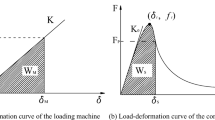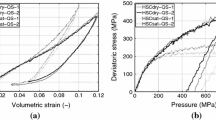Abstract
In the context of an international co-operation project between the University of Delft (The Netherlands) and the LCPC, an experimental study was made of rate effects in the behaviour of concrete under tensile stress. Very high speed tests (\(\dot \sigma \) between 1 and 80 GPa s−1) were carried out in Delft on a Hopkinson bar, and quasi-static tests (\(\dot \sigma \) between 5×10−5 and 5×10−3 GPa s−1) were carried out by the LCPC on a hydraulic press. This investigation had two objectives. 1. To verify on a mini-concrete (diameter of the largest particles 10 mm) a result obtained with a micro-concrete (diameter of the largest particles 2 mm) in the course of a previous study. Rate effects are produced by the presence of pore water in the material. 2. To investigate the influence of the water/cement ratio (i.e., the compressive strength of the concrete) on these rate effects. The three main conclusions that can be drawn from this study are (i) it is indeed the presence of pore water in the concrete which is at the origin of rate effects where this materials is concerned, (ii) the effect of speed on the tensile strengthf 1 increases with the water/cement ratio, and (iii) in absolute value, the increase in strength (f tdyn-f tstat ) seems to be independent of the water/cement ratio.
Resume
Dans le cadre d'une coopération internationale entre l'Université de Delft (Pays-Bas), et le Laboratoire Central des Ponts et Chaussées (LCPC), une étude expérimentale a été menée sur les effects de vitesses dans le comportement en traction du béton. Les essais très rapides (\(\dot \sigma \) compris entre 1 et 80 GPa s−1) ont été réalisés à Delft sur une barre d'Hopkinson, les essais quasi-statiques (\(\dot \sigma \) compris entre 5×10−3 et 5×10−5 GPa s−1) étant réalisés au LCPC sur une presse hydraulique. Deux objectifs sont visés dans cette étude: (i) vérifier sur un mini-béton (diamètre du plus gros grain égal à 10 mm) un résultant obtenu sur micro-béton (plus gros grain égal à 2 mm) lors d'une étude précédente: c'est la présence d'eau libre au sein du matériau qui induit les effects de vitesse; et (ii) étudier l'influence du rapport eau/ciment (c'est-à-dire de la résistance en compression du béton) sur ces effets de vitesse. Les conclusions principales que l'on peut tirer de cette étude sont les trois suivantes: c'est bien la présence d'eau libre dans les bétons qui est l'origine des effects de vitesse relatifs à ce matériau; l'effet de vitesse sur la résistance en traction f1 augmente avec le rapport eau/ciment; et en valeur absolue, l'augmentation de la résistance (f tdyn-f tstat ) semble indépendante de ce rapport eau/ciment.
Similar content being viewed by others
References
Reinhardt, H. W., Rossi, P. and Van Mier, J. G. M., ‘Joint investigation of concrete at high rates of loading’,Mater. Struct. 23 (1990) 213–216.
Rossi, P. Van Mier, J. G. M., Boulay, C. and Le Maou, F., ‘The dynamic behaviour of concrete: influence of free water’,Ibid. 25 (1992) 509–514.
Attolou, A., Belloc, A. and Torrenti, J. M., ‘Méthodologie pour une nouvelle protection du béton vis-à-vis de la déssication’,Bull. Liaison LPC,164 (nov.–déc 1989), in French.
Reinhardt, H. W., Körmeling, H. A. and Zielinski, A. J., ‘The split Hopkinson bar, a versatile tool for impact testing of concrete’,Mater. Struct. 19 (1986) 55–63.
Boulay, C. and Colson, A., ‘A concrete extensometer eliminating the influence of transverse strains on the measurement, of longitudinal strains’,Ibid.,14(79) (1981) 35–38, in French.
Author information
Authors and Affiliations
Rights and permissions
About this article
Cite this article
Rossi, P., Van Mier, J.G.M., Toutlemonde, F. et al. Effect of loading rate on the strength of concrete subjected to uniaxial tension. Materials and Structures 27, 260–264 (1994). https://doi.org/10.1007/BF02473042
Issue Date:
DOI: https://doi.org/10.1007/BF02473042




